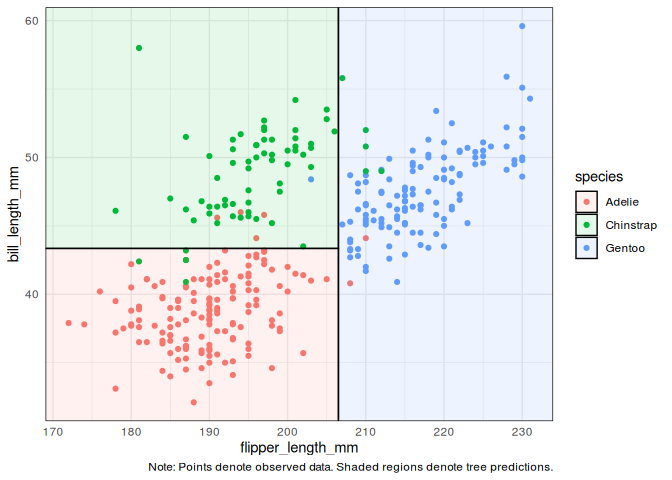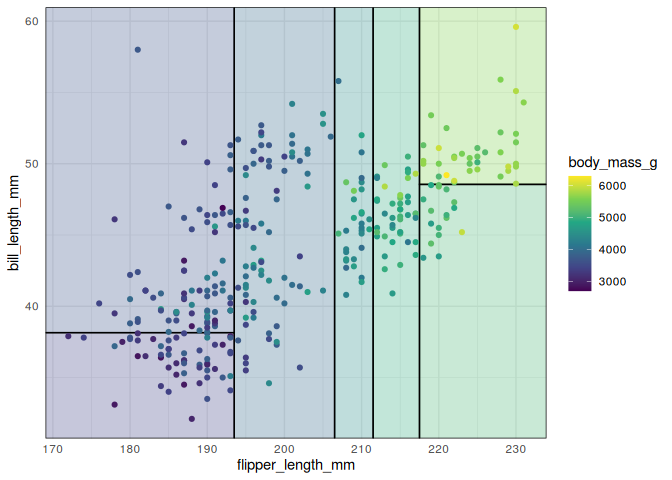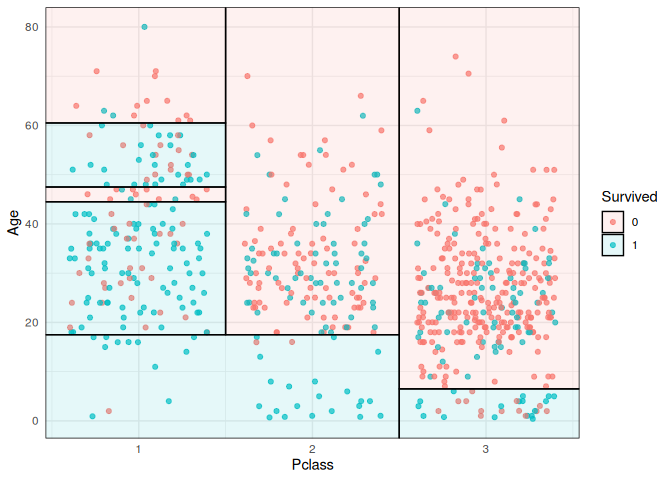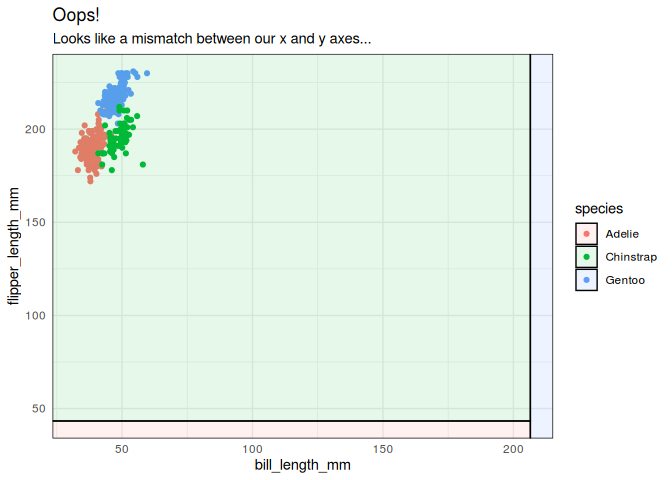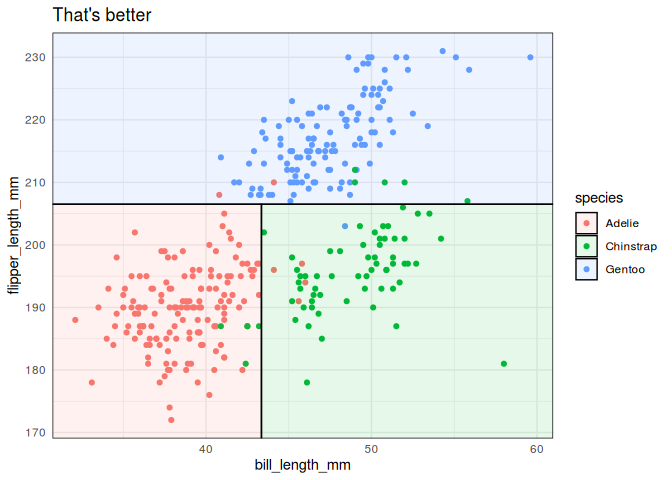A set of simple functions for visualizing decision tree partitions in R with ggplot2.
This package is not yet on CRAN, but can be installed from GitHub with:
# install.packages("remotes")
remotes::install_github("grantmcdermott/parttree")The main function that users will interact with is geom_parttree().
Here’s a simple example using the
palmerpenguins
dataset.
library(palmerpenguins) ## For 'penguins' dataset
library(rpart) ## For fitting decisions trees
library(parttree) ## This package (will automatically load ggplot2 too)
#> Loading required package: ggplot2
## First construct a scatterplot of the raw penguin data
p = ggplot(data = penguins, aes(x = flipper_length_mm, y = bill_length_mm)) +
geom_point(aes(col = species)) +
theme_minimal()
## Fit a decision tree using the same variables as the above plot
tree = rpart(species ~ flipper_length_mm + bill_length_mm, data = penguins)
## Visualise the tree partitions by adding it via geom_parttree()
p +
geom_parttree(data = tree, aes(fill=species), alpha = 0.1) +
labs(caption = "Note: Points denote observed data. Shaded regions denote tree predictions.")
#> Warning: Removed 2 rows containing missing values (geom_point).Trees with continuous independent variables are also supported. However, I recommend adjusting the plot fill aesthetic, since your tree will likely partition the data into intervals that don’t match up exactly with the raw data.
tree2 = rpart(body_mass_g ~ flipper_length_mm + bill_length_mm, data=penguins)
p2 =
ggplot(data = penguins, aes(x = flipper_length_mm, y = bill_length_mm)) +
geom_parttree(data = tree2, aes(fill=body_mass_g), alpha = 0.3) +
geom_point(aes(col = body_mass_g)) +
theme_minimal()
## Legend scales don't quite match (try it yourself)
# p2
## Better to scale fill to the original data
## This does the job but is still kind of hard to make out (again, try yourself)
# p2 +
# scale_fill_continuous(limits = range(penguins$body_mass_g, na.rm = TRUE))
## Even better to combine fill scaling with a mixed colour palette
p2 +
scale_colour_viridis_c(
limits = range(penguins$body_mass_g, na.rm = TRUE),
aesthetics = c('colour', 'fill')
)
#> Warning: Removed 2 rows containing missing values (geom_point).Currently, the package only works with decision trees created by the
rpart
package. However, it does support other front-end modes that call
rpart::rpart() as the underlying engine; in particular the
parsnip and
mlr3 packages. Here’s an example with
the former.
library(parsnip)
library(titanic) ## Just for a different data set
set.seed(123) ## For consistent jitter
titanic_train$Survived = as.factor(titanic_train$Survived)
## Build our tree using parsnip (but with rpart as the model engine)
ti_tree =
decision_tree() %>%
set_engine("rpart") %>%
set_mode("classification") %>%
fit(Survived ~ Pclass + Age, data = titanic_train)
## Plot the data and model partitions
titanic_train %>%
ggplot(aes(x=Pclass, y=Age)) +
geom_jitter(aes(col=Survived), alpha=0.7) +
geom_parttree(data = ti_tree, aes(fill=Survived), alpha = 0.1) +
theme_minimal()
#> Warning: Removed 177 rows containing missing values (geom_point).Underneath the hood, geom_parttree() is calling the companion
parttree() function, which coerces the rpart tree object into a
data frame that is easily understood by ggplot2. For example,
consider again our first “tree” model from earlier. Here’s the print
output of the raw model.
tree
#> n=342 (2 observations deleted due to missingness)
#>
#> node), split, n, loss, yval, (yprob)
#> * denotes terminal node
#>
#> 1) root 342 191 Adelie (0.441520468 0.198830409 0.359649123)
#> 2) flipper_length_mm< 206.5 213 64 Adelie (0.699530516 0.295774648 0.004694836)
#> 4) bill_length_mm< 43.35 150 5 Adelie (0.966666667 0.033333333 0.000000000) *
#> 5) bill_length_mm>=43.35 63 5 Chinstrap (0.063492063 0.920634921 0.015873016) *
#> 3) flipper_length_mm>=206.5 129 7 Gentoo (0.015503876 0.038759690 0.945736434) *And here’s what we get after we feed it to parttree().
parttree(tree)
#> node species path xmin
#> 1 3 Gentoo flipper_length_mm >= 206.5 206.5
#> 2 4 Adelie flipper_length_mm < 206.5 --> bill_length_mm < 43.35 -Inf
#> 3 5 Chinstrap flipper_length_mm < 206.5 --> bill_length_mm >= 43.35 -Inf
#> xmax ymin ymax
#> 1 Inf -Inf Inf
#> 2 206.5 -Inf 43.35
#> 3 206.5 43.35 InfAgain, the resulting data frame is designed to be amenable to a
ggplot2 geom layer, with columns like xmin, xmax, etc.
specifying aesthetics that ggplot2 recognises. (Fun fact:
geom_parttree() is really just a thin wrapper around geom_rect().)
The goal of the package is to abstract away these kinds of details from
the user, so we can just specify geom_parttree() — with a valid tree
object as the data input — and be done with it. However, while this
generally works well, it can sometimes lead to unexpected behaviour in
terms of plot orientation. That’s because it’s hard to guess ahead of
time what the user will specify as the x and y variables (i.e. axes) in
their other plot layers. To see what I mean, let’s redo our penguin plot
from earlier, but this time switch the axes in the main ggplot() call.
## First, redo our first plot but this time switch the x and y variables
p3 =
ggplot(
data = penguins,
aes(x = bill_length_mm, y = flipper_length_mm) ## Switched!
) +
geom_point(aes(col = species)) +
theme_minimal()
## Add on our tree (and some preemptive titling..)
p3 +
geom_parttree(data = tree, aes(fill = species), alpha = 0.1) +
labs(
title = "Oops!",
subtitle = "Looks like a mismatch between our x and y axes..."
)
#> Warning: Removed 2 rows containing missing values (geom_point).As was the case here, this kind of orientation mismatch normally
(hopefully) be pretty easy to recognize. To fix, we can use the
flipaxes = TRUE argument to flip the orientation of the
geom_parttree layer.
p3 +
geom_parttree(
data = tree, aes(fill = species), alpha = 0.1,
flipaxes = TRUE ## Flip the orientation
) +
labs(title = "That's better")
#> Warning: Removed 2 rows containing missing values (geom_point).